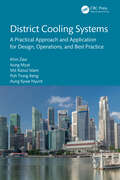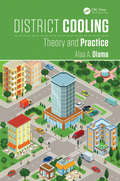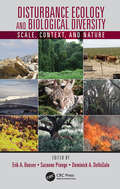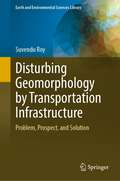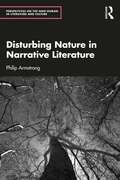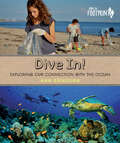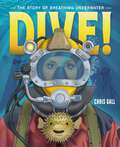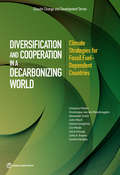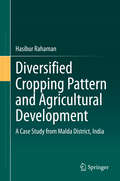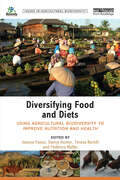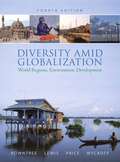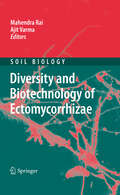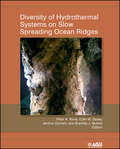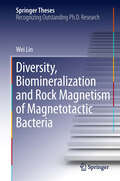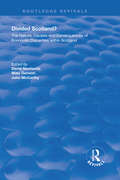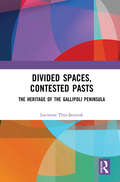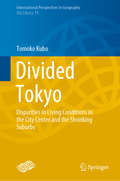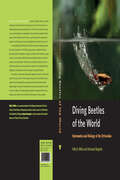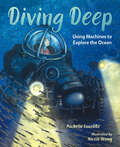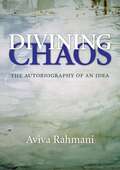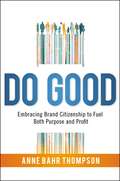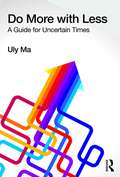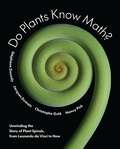- Table View
- List View
District Cooling Systems: A Practical Approach and Application for Design, Operations, and Best Practice
by Aung Myat Md Raisul Islam Khin Zaw Poh Tiong Keng Aung Kywe NyuntThis book draws on the authors’ industry and academic expertise to explain the theory and practice of district cooling systems (DCS). The in-depth exploration of the design and development of DCS presents detailed best practices for their optimization in both the development and operation phases.Readers will gain in-depth practical knowledge on all areas and considerations related to DCS technology's best practices, including current practical research areas and future potential research areas. This book addresses five areas related to DCS: the fundamentals of DCS technology, design optimization for development purposes, real-time optimization for daily operations, techno-commercial decision-making framework, and industry best practice. This information is presented through analyses of technological progress to date; case studies of current operations; and in-depth discussions of the theoretical bases and commercial, technical, and environmental benefits. Through this book, readers can recognize and apply best practices for the design, development, and operation of an optimal DCS design based on multiple factors including financial analysis, energy efficiency considerations, and practical operation issues. This will enable them to contribute to national and international sustainable development goals regarding sustainable cities and climate action.As this book provides both industry know-how and future research directions related to DCS, it is invaluable for DCS industry professionals and advanced undergraduate and postgraduate engineering students who aim to enter this industry and develop leading, highly efficient DCS systems. Overall, it is a vital resource for anyone involved in the planning, execution, and management of DCS projects.
District Cooling: Theory and Practice (Heat Transfer #7)
by Alaa A. OlamaDISTRICT COOLING: THEORY and PRACTICE provides a unique study of an energy cogeneration system, set up to bring chilled water to buildings (offices, apartment houses, and factories) needing cooling for air conditioning and refrigeration. In winter, the source for the cooling can often be sea water, so it is a cheaper resource than using electricity to run compressors for cooling. The related technology of District Heating has been an established engineering practice for many years, but District Cooling is a relatively new technology now being implemented in various parts of the world, including the USA, Arab Emirates and Kuwait, and Saudi Arabia. Existing books in the area are scarce, and do not address many of the crucial issues facing nations with high overall air temperatures, many of which are developing District Cooling plans using sea water. DISTRICT COOLING: THEORY & PRACTICE integrates the theory behind district cooling planning with the practical engineering approaches, so it can serve the policy makers, engineers, and planners whose efforts have to be coordinated and closely managed to make such systems effective and affordable. In times of rising worldwide temperatures, District Cooling is a way to provide needed cooling with energy conservation and sustainability. This book will be the most up-to-date and comprehensive study on the subject, with Case Studies describing real projects in detail.
Disturbance Ecology and Biological Diversity: Context, Nature, and Scale
by Erik A. Beever Inger Suzanne Prange Dominick A. DellaSalaThis book presents cascading effects of ecological disturbances on a multitude of ecosystem components. It includes agricultural development, large infrequent disturbances, forest harvesting, non-native grazing in deserts, ground transportation, powerline corridors, fires, urban ecology, disturbance in aquatic ecosystems, land-use dynamics on diversity, habitat fragmentation, sedimentation of wetlands, and contemporary climate change. The book facilitates users in understanding why disturbances are occurring while recommending mitigation and remediation strategies.
Disturbing Geomorphology by Transportation Infrastructure: Problem, Prospect, and Solution (Earth and Environmental Sciences Library)
by Suvendu RoyThis book focuses on a significant branch of anthropogeomorphology, which is not adequately studied: the impact of transportation systems on altering earth surface processes and landforms. This book fills the gap with in-depth study on the interaction between individual modes of transport network (e.g., trail, roads, railways, waterways, airports, and tunnel) and surface hydro-geomorphology with intensive literature review, fieldwork, geo-environmental modelling, mapping, case studies, and examples from different parts of the world. On the one hand, this book also addresses the vulnerability of transport networks from climate change and critical geo-hazards like floods, landslides, etc. with case studies from the high-risk zones of India. Overall, this book promotes peaceful harmony between the transport network and its surrounding landscapes as an essential lesson for policymakers, planners, and stakeholders.
Disturbing Nature in Narrative Literature (Perspectives on the Non-Human in Literature and Culture)
by Philip ArmstrongDisturbing Nature in Narrative Literature identifies and analyses encounters with unexpected, disconcerting, and unsettling aspects of the natural world, as these have been represented across a wide range of literary texts. It includes in‑depth discussion of both familiar and less familiar works from the British, American, and European literary traditions, and from the Classical period to today. The motifs discussed include earthquakes, forests, storms, animals, and oceanic depth, and the writers include Virgil, Ovid, Dante, Shakespeare, Aphra Behn, Voltaire, Heinrich von Kleist, Herman Melville, H.G. Wells, J.R.R. Tolkien, Gabriel García Márquez, José Saramago, Margaret Atwood, and Annie Proulx. Rich in both close textual analysis and contextual discussion, Disturbing Nature in Narrative Literature offers a vivid introduction to several topical approaches to literary‑critical analysis, including ecocriticism, new materialism, affect theory, and human‑animal studies, thereby demonstrating how literature shapes and is shaped by our response to the pressing questions of our time.
Dive In!: Exploring Our Connection with the Ocean (Orca Footprints #14)
by Ann ErikssonWe're all connected to the ocean, and the ocean to us. The ocean provides half the oxygen we breathe; it feeds us, creates our weather and provides us with water. But we haven't been as kind to the ocean in return. The problems are many: pollution, overfishing, rising seas and acid waters. What can be done? Don't despair; take action. Dive In! explores our intimate connection with the ocean and provides every reader with an achievable set of actions that can help improve ocean health for our sake and the sake of the millions of marine plants and animals that share the planet with us. Filled with colorful photos and positive stories, Dive In! is as informative as it is inspirational. The epub edition of this title is fully accessible.
Dive!: The Story of Breathing Underwater
by Chris GallDIVE! is a fascinating introduction to the comprehensive world history of diving by award-winning artist Chris Gall.How do you breathe underwater? What tools can we use to go deeper and deeper into the oceans? And...what's down there?Two-thirds of our Earth is covered in ocean, yet only 5% of it has been explored. DIVE deep into our long history of sea exploration to learn why, how, and when humans have dived, and uncover our biggest questions about what hides in the Earth's deepest waters.Perfect for STEM-oriented minds and young and old readers fascinated by the sea, Dive! is a must-have to add to any nonfiction shelf.
Diversification and Cooperation in a Decarbonizing World: Climate Strategies for Fossil Fuel-Dependent Countries (Climate Change and Development)
by John Rogers Ward Alexander Golub Grzegorz Peszko Dominique van der Mensbrugghe Cor Marijs Anne Schopp Amelia MidgleyThis book is the first stocktaking of what the decarbonization of the world economy means for fossil fuel†“dependent countries. These countries are the most exposed to the impacts of global climate policies and, at the same time, are often unprepared to manage them. They depend on the export of oil, gas, or coal; the use of carbon-intensive infrastructure (for example, refineries, petrochemicals, and coal power plants); or both. Fossil fuel†“dependent countries face financial, fiscal, and macro-structural risks from the transition of the global economy away from carbon-intensive fuels and the value chains based on them. This book focuses on managing these transition risks and harnessing related opportunities. Diversification and Cooperation in a Decarbonizing World identifies multiple strategies that fossil fuel†“dependent countries can pursue to navigate the turbulent waters of a low-carbon transition. The policy and investment choices to be made in the next decade will determine these countries’ degree of exposure and overall resilience. Abandoning their comfort zones and developing completely new skills and capabilities in a time frame consistent with the Paris Agreement on climate change is a daunting challenge and requires long-term revenue visibility and consistent policy leadership. This book proposes a constructive framework for climate strategies for fossil fuel†“dependent countries based on new approaches to diversification and international climate cooperation. Climate policy leaders share responsibility for creating room for all countries to contribute to the goals of the Paris Agreement, taking into account the specific vulnerabilities and opportunities each country faces.
Diversified Cropping Pattern and Agricultural Development: A Case Study from Malda District, India
by Hasibur RahamanThis book examines how crop diversification strategies can help to ensure sustainable agricultural development across different land-size categories, with a focus on Malda District in West Bengal, India. Using Malda as the study area, a region with nearly 4 million people, the book assesses the extent, pattern, factors and future of crop diversification and its contribution to the development of agriculture in Malda and in India as a whole. The work presents data from 1995-2015 concerning changing cropping patterns at various land-size distributions, and analyzes the information over the twenty year period to understand the link between crop diversification and agricultural development, in order to combat major agricultural issues and make suitable policy recommendations at micro (rural) and macro (urban) levels of agricultural planning. The study is a unique contribution to the field of agricultural geography, and will be of use to students and researchers, as well as government organizations, city/community planners and agriculture managers.
Diversifying Food and Diets: Using Agricultural Biodiversity to Improve Nutrition and Health (Issues in Agricultural Biodiversity)
by Danny Hunter Federico Mattei Jessica Fanzo Teresa BorelliCurrently 868 million people are undernourished and 195 million children under five years of age are stunted. At the same time, over 1 billion people are overweight and obese in both the developed and developing world. Diseases previously associated with affluence, such as cancer, diabetes and cardio-vascular disease, are on the rise. Food system-based approaches to addressing these problems that could enhance food availability and diet quality through local production and agricultural biodiversity often fall outside the traditional scope of nutrition, and have been under-researched. As a consequence, there remains insufficient evidence to support well-defined, scalable agricultural biodiversity interventions that can be linked to improvements in nutrition outcomes. Agricultural biodiversity is important for food and nutritional security, as a safeguard against hunger, a source of nutrients for improved dietary diversity and quality, and strengthening local food systems and environmental sustainability. This book explores the current state of knowledge on the role of agricultural biodiversity in improving diets, nutrition and food security. Using examples and case studies from around the globe, the book explores current strategies for improving nutrition and diets and identifies key research and implementation gaps that need to be addressed to successfully promote the better use of agricultural biodiversity for rural and urban populations and societies in transition.
Diversity Amid Globalization 4th Edition
by Lester Rowntree Martin Lewis Marie Price William WyckoffThe globalization approach challenges students to make critical comparisons between the regions of the world in order to understand them more fully. Examples of the sorts of topics used to accomplish these goals include: The rise of Islamic fundamentalism in SW Asia. Aboriginal groups using high-technology tools to forge common political survival strategies. The economic and political integration of the European Union, contrasted with micronationalism and the factionalism in Europe. Ethnic diversification in the face of strong participation in the global assembly line in SE Asia. The globalization and localization of beer consumption and production in the United States and Canada.
Diversity and Biotechnology of Ectomycorrhizae
by Ajit Varma Mahendra RaiEctomycorrhizal fungi play multifunctional roles during symbioses with higher plants. They can serve as bioprotectors, biofertilizers, bioremediators and stress indicators. Further, they are the true "mycoindicators" of forest ecosystems, where an enormous diversity of ectomycorrhizal fungi can be found. Some ectomycorrhizal fungi also produce edible sporocarps, i.e., fruiting bodies, which are important for the food industry. Ectomycorrhizal fungi also produce various metal chelating molecules, which are of remarkable biotechnological significance and which also secrete useful secondary metabolites. Molecular approaches are required for the identification and differentiation of fungi forming symbioses with higher plants, while molecular tools are important to understand how genes are expressed during symbiosis with higher plants. Students, researchers and teachers of botany, mycology, microbiology, forestry, and biotechnology will find a valuable source of information in this Soil Biology volume.
Diversity of Hydrothermal Systems on Slow Spreading Ocean Ridges, 1st Edition
by Peter A. Rona Bramley J. Murton Jérôme Dyment Colin W. DeveyPublished by the American Geophysical Union as part of the Geophysical Monograph Series, Volume 188.Diversity of Hydrothermal Systems on Slow Spreading Ocean Ridges presents a multidisciplinary overview of the remarkable emerging diversity of hydrothermal systems on slow spreading ocean ridges in the Atlantic, Indian, and Arctic oceans. When hydrothermal systems were first found on the East Pacific Rise and other Pacific Ocean ridges beginning in the late 1970s, the community consensus held that the magma delivery rate of intermediate to fast spreading was necessary to support black smoker-type high-temperature systems and associated chemosynthetic ecosystems and polymetallic sulfide deposits. Contrary to that consensus, hydrothermal systems not only occur on slow spreading ocean ridges but, as reported in this volume, are generally larger, exhibit different chemosynthetic ecosystems, produce larger mineral deposits, and occur in a much greater diversity of geologic settings than those systems in the Pacific. The full diversity of hydrothermal systems on slow spreading ocean ridges, reflected in the contributions to this volume, is only now emerging and opens an exciting new frontier for ocean ridge exploration, includingProcesses of heat and chemical transfer from the Earth's mantle and crust via slow spreading ocean ridges to the oceansThe major role of detachment faulting linking crust and mantle in hydrothermal circulationChemical reaction products of mantle involvement including serpentinization, natural hydrogen, abiotic methane, and hydrocarbon synthesisGeneration of large polymetallic sulfide deposits hosted in ocean crust and mantleChemosynthetic vent communities hosted in the diverse settingsThe readership for this volume will include schools, universities, government laboratories, and scientific societies in developed and developing nations, including over 150 nations that have ratified the United Nations Convention on the Law of the Sea.
Diversity, Biomineralization and Rock Magnetism of Magnetotactic Bacteria
by Wei LinMagnetotactic bacteria (MTB) synthesize intracellular nano-sized minerals of magnetite and/or greigite magnetosomes for magnetic orientation. They play important roles in global iron cycling and sedimentary magnetism, and have a broad range of potential applications in both biotechnological and biomedical fields. However, because the majority of MTB in nature remain unculturable, our understanding of these specific bacteria remains fairly limited. This thesis describes the development of a novel approach for effectively collecting, purifying and characterizing uncultivated magnetotactic bacteria. The diversity, genomic information and rock magnetic properties of various uncultivated MTB are investigated and characterized using a combination of biological and geophysical methods. The results will lead to a better understanding of the biogeography and biomineralization mechanisms of MTB in nature, and improve our knowledge of the contributions of MTB to biogeochemical cycles of elements and sedimentary magnetism. Dr. Wei Lin works at the Institute of Geology and Geophysics, Chinese Academy of Sciences, China
Divided Scotland?: The Nature, Causes and Consequences of Economic Disparities within Scotland (Routledge Revivals)
by David NewlandsOriginally published in 2004. In recent years, there has been much debate about the economic performance of the Scottish economy in relation to the economy of Britain as a whole. However, with the establishment of the Scottish Parliament, the debate has shifted somewhat to focus on the economic disparities between areas within Scotland. Leading Scottish regional scientists are brought together in this volume to examine the nature, causes and consequences of these regional economic disparities. Following an introductory overview, the book divides into two main sections. The first section examines and compares three key areas in detail: the Highlands and Islands; Edinburgh and its hinterland; and Greater Glasgow. The second section covers a number of cross-cutting issues, such as economic development, education and training, transport and communications and community planning. It concludes with a critical appraisal of the various policies discussed and their implications.
Divided Spaces, Contested Pasts: The Heritage of the Gallipoli Peninsula
by Lucienne Thys-ŞenocakThe Gallipoli peninsula in Turkey was the site of one of the most tragic and memorable battles of the twentieth century, with the Turks fighting the ANZAC (Australian New Zealand Army Corps) and soldiers from fifteen other countries. This book explores the history of its landscape, its people, and its heritage, from the day that the defeated Allied troops of World War One evacuated the peninsula in January 1916 to the present. It examines how the wartime heritage of this region, both tangible and intangible, is currently being redefined by the Turkish state to bring more of a faith-based approach to the secularist narratives about the origins of the country. It provides a timely and fascinating look at what has happened in the last century to a landscape that was devastated and emptied of its inhabitants at the end of World War One, how it recovered, and why this geography continues to be a site of contested heritage. This book will be a key text for scholars of cultural and historical geography, Ottoman and World War One archaeology, architectural history, commemorative and conflict studies, European military history, critical heritage studies, politics, and international relations.
Divided Tokyo: Disparities in Living Conditions in the City Center and the Shrinking Suburbs (International Perspectives in Geography #11)
by Tomoko KuboThis book explores how and why Tokyo has been divided over time in terms of living conditions. First, recent urban discourses that explain the transformation of Tokyo’s urban structure are examined, along with social changes and the expansion of unequal residential conditions within the metropolitan area. Chapter 1 reviews: 1) discussions on globalization, neo-liberalization, and changes in housing policies; 2) debates on the divided city; 3) debates on the shrinking city and the urban lifecycle; 4) discussion of the urban residential environment from a social justice perspective; and 5) family–housing relationships in the post-growth society. Based on the literature review, the rest of the book is structured as follows. Chapter 2 explains the changes in urban and housing policies, demography, and socio-economic conditions. In Chapters 3 to 5, the background and characteristics of the growth of condominium living in the city center are examined. The next three chapters analyze the reality of shrinking suburbs, using case studies to demonstrate the increase in vacant housing and local responses toward shrinkage. In Chapter 9, possible solutions are proposed for dealing with problems related to urban shrinkage and the expanding gap in terms of the availability of investments to stimulate urban development, the residential environment, and the population age structure in Japanese cities by comparing the author’s findings and the literature review. This book provides deep insights for urban and housing scholars, urban planners, policy decision-makers, and local communities that struggle with aging populations and urban shrinkage.
Diving Beetles of the World: Systematics and Biology of the Dytiscidae
by Kelly B. Miller Johannes BergstenThe first comprehensive book in more than a century to reveal the diversity and natural history of diving beetles.Among the hundreds of thousands of species of beetles, there is one family, containing some 4,300 species, that stands out as one of the most diverse and important groups of aquatic predatory insects. This is the Dytiscidae, whose species are commonly known as diving beetles. No comprehensive treatment of this group has been compiled in over 130 years, a period during which a great many changes in classification and a near quadrupling of known species has occurred.In Diving Beetles of the World, Kelly B. Miller and Johannes Bergsten provide the only full treatments of all 188 Dytiscid genera ever assembled. Entomologists, systematists, limnologists, ecologists, and others with an interest in aquatic systems or insect diversity will find these extensively illustrated keys and taxon accounts immensely helpful. The keys make it possible to identify all taxa from subfamily to genera, and each key and taxon treatment is accompanied by both photographs and detailed pen-and-ink drawings of diagnostic features. Every genus account covers body length, diagnostic characters, classification, species diversity, a review of known natural history, and world distribution. Each account is also accompanied by a range map and at least one high-resolution habitus image of a specimen. Diving beetles are fast becoming important models for aquatic ecology, world biogeography, population ecology, and animal sexual evolution and, with this book, the diversity of the group is finally accessible.
Diving Deep: Using Machines to Explore the Ocean
by Michelle CusolitoFrom snorkeling to freediving, scuba, submarines, and Challenger Deep, discover the different technologies scientists use to explore the ocean in this deep-sea STEM picture book.How does ocean exploration work? What kinds of machines and equipment help researchers under the sea? How deep can we dive to find out more about the plants and animals that live in the ocean? For fans of Alvin from Flying Deep, Diving Deep introduces all the ways humans have figured out how to engage with, explore, and learn from the oceans.
Divining Chaos: The Autobiography of an Idea
by Aviva RahmaniA spirited memoir by artist Aviva Rahmani, offering a relatable narrative to discuss trigger point theory and the importance of eco-art activism.Divining Chaos is an intimate personal memoir of unparalleled transparency into the moments in Rahmani's life that shaped her as an artist and activist. Detailing the history that led her to two seminal projects—Ghost Nets, restoring a coastal town dump to flourishing wetlands, and The Blued Trees Symphony, which applied her premises to challenge natural gas pipelines with a novel legal theory about land use—Rahmani shares the decisions that shaped her life’s work and thinking. Her discussions about trigger point theory argue for how to predict, confront, and determine outcomes to the ecological challenges we face today.
Do Forests Need Fires?
by Liz HuyckNot all forest fires are bad. Controlled burns actually help keep the forest healthy, clear the way for new vegetation, and act as a pest control.
Do Good: Embracing Brand Citizenship to Fuel Both Purpose and Profit
by Anne Bahr ThompsonGood works are no longer optional.For many businesses, success comes in unexpected ways. Toms grew into a $600 million company by giving away 35 million pair of shoes. Patagonia’s profits have climbed year after year even as it funnels heavy investments into sustainability.And it’s not just millennials rewarding companies with causes. In every age group, people commit to brands that show good citizenship. From CVS’s destocking cigarettes to Chipotle’s ethical sourcing, people want to see fair employment practices, social responsibility, and charitable giving — and they quickly call out negligence.Based on extensive research with thousands of consumers, Do Good documents this sea change and explains how to embed social consciousness into a company’s DNA. Packed with examples and original data, the five-step model highlights the new rules of business:TRUST: Deliver on promisesENRICHMENT: Make daily life easier or more inspiringRESPONSIBILITY: Treat people and the environment with respectCOMMUNITY: Mirror values shared by customers, employees, and partnersCONTRIBUTION: Make a difference in the world.Buyers today demand more than half-hearted pledges. By actively linking great brands with higher purposes, companies capture both markets and hearts.
Do More with Less: A Guide for Uncertain Times
by Uly MaIn current, uncertain times, it is important for businesses, whether private, public or third sector, to prepare for unexpected impacts. This book offers a way forward that brings the individuals and their employers together to deliver a future that is ready to take advantage of opportunities, be ready for threats, "do sustainability" and save money at the same time. Do More with Less takes conventional improvement techniques and suggests new ways to deploy them to improve both Efficiency and Effectiveness of organisations. The proposed programme is cost-neutral since it can be paid out of the reduction of inefficiency and ineffectiveness: wasted time, effort, materials and budget. At a strategic level, this book introduces a key performance indicator linking resource use to corporate effectiveness, thereby bringing together sustainability, business success and waste reduction. The contents then cover the entire improvement process from initial audit through to implementing the improvements together with useful suggestions on ways to maintain the success and to control the gains. Techniques such as problem spotting and developing real-world solutions are presented as well as the necessary communications and marketing tools to support the improvement process. This book is aimed at individuals who wants to make a difference at work personally and at organisations that want to be successful in difficult and uncertain times. It presents ideas and techniques that are easy to learn, simple to carry out and practical to everyone.
Do Plants Know Math?: Unwinding the Story of Plant Spirals, from Leonardo da Vinci to Now
by Stéphane Douady Jacques Dumais Christophe Golé Nancy PickA breathtakingly illustrated look at botanical spirals and the scientists who puzzled over themCharles Darwin was driven to distraction by plant spirals, growing so exasperated that he once begged a friend to explain the mystery &“if you wish to save me from a miserable death.&” The legendary naturalist was hardly alone in feeling tormented by these patterns. Plant spirals captured the gaze of Leonardo da Vinci and became Alan Turing&’s final obsession. This book tells the stories of the physicists, mathematicians, and biologists who found themselves magnetically drawn to Fibonacci spirals in plants, seeking an answer to why these beautiful and seductive patterns occur in botanical forms as diverse as pine cones, cabbages, and sunflowers.Do Plants Know Math? takes you down through the centuries to explore how great minds have been captivated and mystified by Fibonacci patterns in nature. It presents a powerful new geometrical solution, little known outside of scientific circles, that sheds light on why regular and irregular spiral patterns occur. Along the way, the book discusses related plant geometries such as fractals and the fascinating way that leaves are folded inside of buds. Your neurons will crackle as you begin to see the connections. This book will inspire you to look at botanical patterns—and the natural world itself—with new eyes.Featuring hundreds of gorgeous color images, Do Plants Know Math? includes a dozen creative hands-on activities and even spiral-plant recipes, encouraging readers to explore and celebrate these beguiling patterns for themselves.
Do Tornadoes Really Twist? Questions and Answers About Tornadoes and Hurricanes
by Melvin Berger Gilda BergerHow is a hurricane born? What color are tornado funnels? The fascinating answers to these and many more questions about tornadoes and hurricanes await curious minds. This book will not only intrigue readers, but will help them prepare for a storm.
